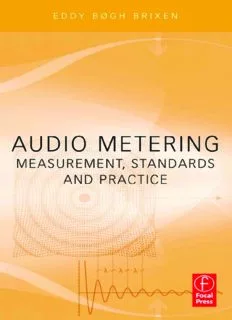Table Of ContentAudio Metering
Measurements, Standards and Practice
This page intentionally left blank
Audio Metering
Measurements, Standards and Practice
Eddy B. Brixen
AMSTERDAMlBOSTONlHEIDELBERGlLONDONlNEWYORKlOXFORD
PARISlSANDIEGOlSANFRANCISCOlSINGAPORElSYDNEYlTOKYO
FocalPressisanImprintofElsevier
FocalPressisanimprintofElsevier
TheBoulevard,LangfordLane,Kidlington,Oxford,OX51GB,UK
30CorporateDrive,Suite400,Burlington,MA01803,USA
Firstpublished2011
Copyright(cid:1)2011EddyB.Brixen.PublishedbyElsevierInc.AllRightsReserved.
TherightofEddyB.Brixentobeidentifiedastheauthorofthisworkhasbeenassertedin
accordancewiththeCopyright,DesignsandPatentsAct1988
Nopartofthispublicationmaybereproducedortransmittedinanyformorbyanymeans,
electronicormechanical,includingphotocopying,recording,oranyinformationstorageand
retrievalsystem,withoutpermissioninwritingfromthepublisher.Detailsonhowtoseek
permission,furtherinformationaboutthePublisher’spermissionspoliciesandourarrangementwith
organizationssuchastheCopyrightClearanceCenterandtheCopyrightLicensingAgency,canbe
foundatourwebsite:www.elsevier.com/permissions
Thisbookandtheindividualcontributionscontainedinitareprotectedundercopyrightbythe
Publisher(otherthanasmaybenotedherein).
Notices
Knowledgeandbestpracticeinthisfieldareconstantlychanging.Asnewresearchandexperience
broadenourunderstanding,changesinresearchmethods,professionalpractices,ormedical
treatmentmaybecomenecessary.
Practitionersandresearchersmustalwaysrelyontheirownexperienceandknowledgeinevaluating
andusinganyinformation,methods,compounds,orexperimentsdescribedherein.Inusingsuch
informationormethodstheyshouldbemindfuloftheirownsafetyandthesafetyofothers,
includingpartiesforwhomtheyhaveaprofessionalresponsibility.
Tothefullestextentofthelaw,neitherthePublishernortheauthors,contributors,oreditors,assume
anyliabilityforanyinjuryand/ordamagetopersonsorpropertyasamatterofproductsliability,
negligenceorotherwise,orfromanyuseoroperationofanymethods,products,instructions,or
ideascontainedinthematerialherein.
BritishLibraryCataloguinginPublicationData
AcataloguerecordforthisbookisavailablefromtheBritishLibrary
LibraryofCongressControlNumber:2010938289
ISBN:978-0-240-81467-4
ForinformationonallFocalPresspublications
visitourwebsiteatfocalpress.com
PrintedandboundintheUnitedStates
1011121110987654321
Table of Contents
Preface.............................................................................................................vii
1 Acoustic Sound........................................................................................1
2 From AcousticSound toElectrical Signals............................................9
3 Digital Representation...........................................................................11
4 Signal Types...........................................................................................19
5 HowLargeIsanAudioSignal?............................................................33
6 The dB Concept.....................................................................................39
7 The Ear, Hearing, and LevelPerception...............................................47
8 TimeWeighting.....................................................................................57
9 FrequencyWeighting andFilters..........................................................61
10 Determinationof Loudness...................................................................75
11 Characteristics of LevelMeters.............................................................83
12 The Standard Volume Indicator (VU Meter)........................................87
13 Peak Program Metere PPM.................................................................91
14 LoudnessMetering................................................................................95
15 Calibration ofLevelMeters................................................................107
16 Relationships Between Scales.............................................................111
17 Dynamic Scales...................................................................................117
v
vi Table of Contents
18 Polarity andPhase Reading.................................................................121
19 Display ofLevelDistribution..............................................................129
20 Multi-Channel and SurroundSound....................................................135
21 Standards andPractices.......................................................................151
22 Summation ofAudio Signals..............................................................163
23 Digital Interface...................................................................................169
24 Where toConnect aMeter..................................................................181
25 Fast FourierTransformation................................................................193
26 Spectrum Analyzer..............................................................................201
27 Other Measurement Systems...............................................................205
28 MeasurementSignals...........................................................................213
29 Sound LevelMeters.............................................................................215
30 NRand NC Curves..............................................................................219
31 RoomAcoustics Measures..................................................................225
Glossary.........................................................................................................243
Index..............................................................................................................259
Preface
What is dynamic range e and how loud is it? These are the eternal questions
that concerneveryonewhoworkswiththe practical aspectsofsound.
Thisbookwaswrittentogiveeverybodywithaninterestinaudioanexpla-
nation ofthe conditions thatdetermine the answers tothese questions.
Fundamental acoustics, electronics and psycho-acoustic concepts are
described here. A number of topics related to digital technology are also
covered and information can also be obtained here on the majority of the
tools that are used indescribing the magnitude ofsound.
This is the second edition of Audio Metering. The update is particularly
concerned with loudness measures and metering. However, the basic chapters
in the beginning of the book have been expanded and a complete new
chapteron room acoustics hasbeen added.
HOW SHOULD THIS BOOK BE READ?
AudioMeteringcanbeusedasareferencebook.Thebeginningcontainsatable
of contentsand the end ofthe book providesa glossary and anindex.
Readingthebookfromcovertocoverishighlyrecommended.Thesubject
matterofthebookhasbeenorganizedsothatthemostbasicmaterialisplaced
atthebeginning,whilethemoregenerallydescriptivematerialisfoundtowards
the end ofthe book.
Enjoy
Eddy Bøgh Brixen
Smørum, Denmark, September2010
Thanks to my family and to my publisher for the patience they have
displayed during the preparation of this 2nd edition of Audio Metering. Also
thanks to the publisher of the first edition, Broadcast Publishing, for leaving
the rights tothe author.
vii
This page intentionally left blank
Chapter | one
Acoustic Sound
CHAPTER OUTLINE
What Is Sound?.............................................................................................................................1
Speed of Sound............................................................................................................................1
Frequency........................................................................................................................................2
Wavelength.....................................................................................................................................2
Sound Pressure............................................................................................................................4
Conversion Relationships..........................................................................................................4
Sound Power................................................................................................................................4
Sound Intensity.............................................................................................................................5
Sound Fields..................................................................................................................................5
Spherical Sound Field............................................................................................................................5
Cylindrical Sound Field..........................................................................................................................8
Plane Sound Field...................................................................................................................................8
“Sound”isanEnglish-basedword.“Audio”isderivedfromLatin,andrefersto
thingsthatarerelatedtohearing.Sounddoesnotnecessarilyhavetobeaudible.
Infrasound and ultrasound, which are below and above the normal range of
humanhearing,respectively, are examples ofinaudible sounds.
InEnglish,wetendtousetheterms“sound”and“audio”indiscriminately.
When discussing acoustical topics in this book, we will be dealing with
“sound,” andthat iswherewewillbegin.
WHAT IS SOUND?
Sound is normally understood to mean elastic molecular oscillations in air or
other media such as water, iron, or concrete. These oscillations result in pres-
sure variations that are of such a magnitude that they can be sensed by
humanhearing.
However, sound can also be converted to, for example, variations in the
electrical current in a conductor, or magnetic variations on an audio tape, or
a sequence of numeric values. We call these forms intermediate formats,
becausewe later convertthem into acousticsound.
SPEED OF SOUND
Soundpropagatesbyanoscillatingsolidbodysettingtheparticlesnexttoitin
motion, and those next to them, and so on. Sound thus spreads with a certain
1
AudioMetering.DOI:10.1016/B978-0-240-81467-4.10001-2
Copyright(cid:1)2011EddyB.Brixen.PublishedbyElsevierInc.Allrightsreserved.
Description:In this comprehensive guide Eddy Bøgh Brixen will take you through the complex and confusing concept of audio metering, giving you the knowledge and skills you need to utilize optional signal levels and produce high quality audio. Covering all areas of this essential topic, Audio Metering begins wi

